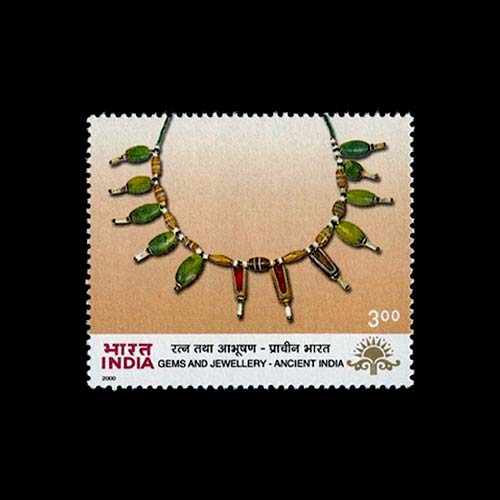Fascinating Archaeological Facts on Postage Stamps - 54
2025-06-26 Thu
All over the world, ornaments are an important aspect of human culture. Archaeological findings in India indicate the use of ornaments dating back to the Upper Paleolithic period, showcasing a variety of raw materials, shapes, sizes, and intricate designs. The earliest ornaments primarily include beads crafted from ostrich shells, discovered at #Bimbetka in Madhya Pradesh and Patne in Maharashtra, with additional examples made from shells and BONES.During the Bronze Age, the Harappan Civilization emerged as a significant center for jewelry production, featuring exquisite pieces constructed from GOLD, terracotta, and shell, alongside a wide array of beads. Excavations at various Harappan sites have unearthed a remarkable collection of ornaments, including beads, pendants, bangles, anklets, and ear studs made from diverse materials.
The Harappan era was characterized by a highly developed bead-making industry. Skilled artisans transformed carnelian, agate, turquoise, steatite, faience, and gold into intricate beads, often interspersed with gold spacers to create remarkable ornaments. Dating between 2600-1900 BCE, the artifacts uncovered from Mohenjodaro and Harappa exhibit a level of sophistication and craftsmanship that is impressive, highlighting advanced metallurgical knowledge and fabrication techniques more than 4,000 years ago.
Necklaces featuring beads and pendants hold a prominent place in the historical narrative of ornaments in the Indian subcontinent. The Harappan people displayed a profound appreciation for necklaces, as evidenced by numerous figurines and the substantial quantity of beads recovered through archaeological excavations.
On 07 December 2000, India #post released a set of six stamps entitled #gems & Jewellery" to celebrate the 14th #asian #International #stamp Exhibition. Among these stamps, one prominently features a bead necklace from the Harappan Civilization, valued at Rs 3.
This particular necklace, currently housed in the National Museum in #Delhi, is composed of steatite and gold beads, each adorned with gold caps on both ends. The piece includes three pendants made of banded agate beads, distinguished by red bands in the center, complemented by five jade bead pendants on one side and four on the opposite.
The beads are suspended on a robust gold wire that passes through each bead, with a projection at the lower end secured by a small cylindrical bead and gold cap. The upper end is coiled to form an eyelet for the cord. This necklace exemplifies the advanced bead-making technology and artistic proficiency that were prevalent during the Harappan period.
Latest News
-
Science and Technology on Indian Postage Stamps-6
2025-11-12 WedSir Mokshagundam Visvesvaraya is regarded as one of India's most distinguished engineers. His innova...
-
Science and Technology on Indian Postage Stamps-5
2025-11-11 TueSir Jagadish Chandra Bose recognized as India's first biophysicist was born on 30 November 1858, in ...
-
'Al-Sultan' Type Copper Double Falus of Malwa Sultan Ghiyath Shah
2025-11-07 FriAnother type of Copper Double Falus of Malwa Sultan Ghiyath Shah, weighing 17.5-18.1g. <br><br> I...
-
Science and Technology on Indian Postage Stamps-4
2025-11-07 FriThe last stamp in the series issued by India Post on 11 September 1997, to commemorate the 50th anni...
-
Science and Technology on Indian Postage Stamps-3
2025-11-06 ThuThe next #stamp in the series issued by #India #post on 11 #September 1997 commemorates the 50th an...

